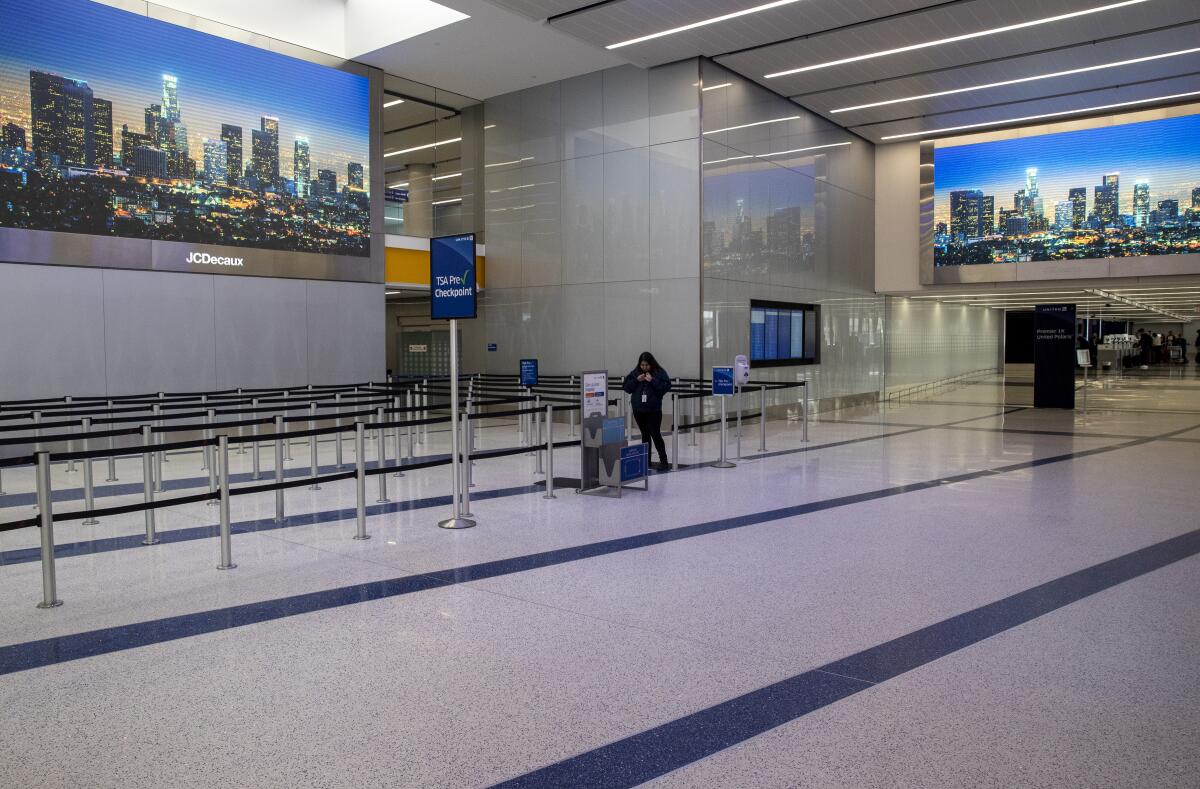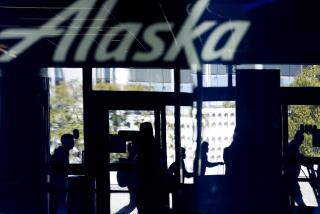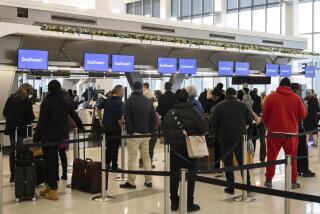Coronavirus flight cuts could extend until summer. Airlines call for $58 billion in aid

- Share via
Responding to new government travel restrictions and plunging demand, U.S. carriers plan to slash flight capacity by up to 75% on international routes and as much as 30% on domestic flights, with cuts projected to last until summer.
The growing coronavirus outbreak also prompted a trade group that represents the U.S. airlines to call on the federal government to provide at least $58 billion in grants, loans and tax breaks to respond to an economic blow that the group called “staggering.”
“This is a today problem, not a tomorrow problem,” Nicholas E. Calio, president and chief executive of Airlines for America, said in a statement Monday. “It requires urgent action.”
Although U.S. carriers had been reporting healthy profits for nearly a decade, the cash reserves the airlines have built are draining quickly, with all seven of the group’s largest carriers expected to run out of money as early as June 30, according to the trade group.
The call for financial aid comes days after President Trump on Saturday urged Americans to avoid flying to slow the spread of the new coronavirus and expanded the U.S. ban on travel from Europe to include the United Kingdom and Ireland.
Flight cancellations are outpacing new bookings and industry leaders say the industry impact is likely to be much worse than after the terrorist attacks of Sept. 11, 2001, when flights were grounded for three days and demand for air travel didn’t recover for months.
Delta Air Lines, one of the world’s largest carriers, said it plans to cut overall capacity by 40% and park 300 planes, describing it as the largest reduction in service in the company’s history.
Representatives of the Atlanta-based carrier said it has already begun to offer voluntary, unpaid, short-term leave to its workers. A hiring freeze took effect last week.
American Airlines said it was cutting capacity on international flights by 75% through May 6 and reducing domestic capacity by 20% in April and 30% in May. The Fort Worth-based carrier is also offering voluntary, unpaid leave to its workers.
United Airlines plans to cut capacity 50% overall through April and May, with such cuts likely to extend into the summer.
Southwest Airlines, the Dallas-based carrier that flies primarily domestic routes, announced in a filing with the Securities and Exchange Commission that it plans to cut capacity by at least 20% in the period between April 14 and June 5.
The carrier is also instituting a hiring freeze and offering leave options to employees. Gary Kelly, chairman of the board and chief executive of the airline, plans to reduce his base salary of $750,000 by 10%.
In a memo to employees Monday, Alaska Airlines said it had processed 362,000 cancellations in the last two days while accepting only 93,000 new reservations. The Seattle-based carrier plans to cut capacity by at least 10% in April and 15% in May.
Airline stocks continued to suffer in the wake of the outbreak, with the Dow Jones U.S. airlines index dropping 8% Monday for a total slide of more than 40% so far this year.
It is not clear yet whether any U.S. airline workers have been laid off as a result of the cuts, but unions that represent the workers say they are bracing for a devastating economic blow.
In a letter Monday to Trump, House Speaker Nancy Pelosi and Senate Majority Leader Mitch McConnell, the Airline Pilots Assn. said its “members have been among the first workers to experience economic hardship: airline pilots have already been furloughed as a result of COVID-19.”
“More furloughs will surely follow if we fail to address this challenge as partners,” said the letter from Joseph G. DePete, president of the association.
In a series of Twitter messages, Sara Nelson, president of the Assn. of Flight Attendants, called for payroll subsidies to prevent layoffs and furloughs that would make it difficult for airlines to rebound once the crisis is over.
“If airlines are slow to recover — other industries will be too. Travel to business conferences, Disneyland, cruises, and casinos is dependent on a functioning aviation industry,” she said.
The union that represents more than 63,000 pilots called on federal lawmakers to ensure that “any economic relief package must contain strong labor protections for the airline employees who have — or will — suffer financial harm, experience quarantine or treatment, or need to care for a loved one.”
The union that represents airline mechanics and railroad workers issued a letter to its 140,000 members Monday, saying, “we must be prepared for short term turmoil that could be even greater than we endured in the wake of the 2001 attacks.”
Such cuts have already begun in Europe. Norwegian Airlines, a low-cost carrier based in Norway, said it will cut 85% of its flights and plans to lay off 7,300 workers, or about 90% of its workforce.
“It is indeed with a heavy heart we have to temporarily lay off more than 7,300 of our colleagues, but we unfortunately have no choice,” Norwegian Chief Executive Jacob Schram said in a statement Monday. “However, I want to emphasize that this is temporary, because when the world returns to normalcy my goal is to keep as many of our dedicated colleagues as possible.”
International Airlines Group, which operates Aer Lingus, British Airways and Iberia, among others, said it plans to cut flight capacity by at least 75% for April and May.
The impact of the crisis is visible at U.S. airports, where lines at terminal gates for domestic flights are unusually light but crowds are big and hectic at international gates where inbound travelers have been scrambling to return to the U.S.
In response to the cuts in flights, the Federal Aviation Administration waived until the end of May a rule that normally requires airlines with a scheduled time slot at a busy airport to use the slot 80% of the time. Under normal circumstances, airlines that fail to use that slot 80% of the time may be forced to give it up.
S&P Global reduced its outlook to negative for United, and put Delta and American Airlines on negative credit watch Monday, saying travel demand may not begin to recover until the end of 2020.
American Airlines, the world’s largest carrier, is reducing costs by about $3 billion in response to the cut in demand, but in a news release, S&P Global predicted the savings will be “more than offset by sharply weaker traffic levels.”
Still, the credit rating company noted that American and United both set aside hefty cash reserves and that the managers of some of the largest carriers have overcome the impacts of the Sept. 11 terrorist attacks and the 2008-09 recession.
More to Read
Inside the business of entertainment
The Wide Shot brings you news, analysis and insights on everything from streaming wars to production — and what it all means for the future.
You may occasionally receive promotional content from the Los Angeles Times.











